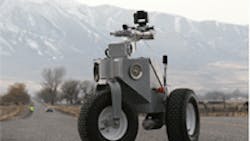Digital drive in omnidirectional unmanned rover
Unmanned vehicles are reaching new levels of sophistication, to perform a wide range of chores that humans would rather not do: hauling, transportation, disposing and disarming of explosives, and surveillance. One specimen, the high-speed vehicle pictured here, is a ground-based unit for industrial and military use that can reach speeds topping 25 mph.
This particular robotic vehicle platform is unique because it's omni-directional; all the wheels steer independently. It's also equipped with a manipulator arm with 5° of freedom and the ability to lift more than 100 lb. at full extension. However, despite its capabilities, the machine’s OEM felt it still had room for improvement, and got in touch with Elmo Motion Control Inc., Westford, Mass., to see what could be done. The initial vehicle design not only fell short on wheel power, but also failed to provide genuine velocity control for the wheels. As a result, the vehicle had limited drive capability on an incline. And when coming to a stop, a final corrective jerk would occur as an effect of the servos closing any position error present.
After considering various solutions, Elmo's team placed compact electronics in the comparably compact vehicle. The company's power-dense Eagle digital drive was selected for the vehicle's drive system, where it provides distributed, encoder-only velocity control for the wheels. Falcon digital drives control the manipulator arm, specifically on the top three upper power arm joints. Here, encoder-only velocity control is used in conjunction with absolute position feedback from an analog encoder. Finally, Harmonica digital drives for both platform steering and lower power manipulator arm joints support up to a 200 Vdc bus, and can control the manipulator arm in encoder-only velocity mode as well.
Eagle and Falcon drives use D-sub style connectors that can withstand the shock and vibration encountered while the vehicle travels through rough terrain. Another key factor is their support of the CANopen protocol, which allows the drives to be mounted near the electrical axis and reduce overall cabling.
Visit Elmo Motion Control for more information.
